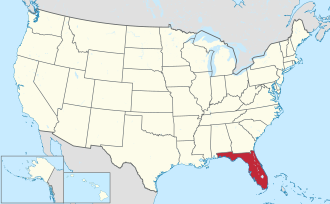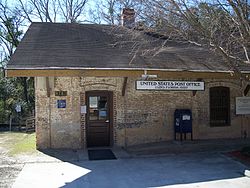2020 census
The 2020 United States census counted 14,510 people, 5,816 households, and 3,762 families in Jefferson County, Florida. [25] [26] The population density was 24.3 per square mile (9.4/km2). There were 6,690 housing units at an average density of 11.2 per square mile (4.3/km2). [26] [27] The racial makeup was 61.37% (8,905) white or European American (60.1% non-Hispanic white), 31.85% (4,621) black or African-American, 0.29% (42) Native American or Alaska Native, 0.23% (34) Asian, 0.03% (4) Pacific Islander or Native Hawaiian, 2.18% (316) from other races, and 4.05% (588) from two or more races. [28] Hispanic or Latino of any race was 4.53% (658) of the population. [29]
Of the 5,816 households, 23.6% had children under the age of 18; 46.2% were married couples living together; 29.1% had a female householder with no spouse or partner present. 30.2% of households consisted of individuals and 15.4% had someone living alone who was 65 years of age or older. [26] The average household size was 2.2 and the average family size was 2.7. [30] The percent of those with a bachelor’s degree or higher was estimated to be 18.2% of the population. [31]
16.9% of the population was under the age of 18, 6.1% from 18 to 24, 20.9% from 25 to 44, 31.3% from 45 to 64, and 24.7% who were 65 years of age or older. The median age was 49.8 years. For every 100 females, there were 93.9 males. [26] For every 100 females ages 18 and older, there were 93.7 males. [26]
The 2016-2020 5-year American Community Survey estimates show that the median household income was $49,081 (with a margin of error of +/- $7,142). The median family income was $62,571 (+/- $4,655). [32] Males had a median income of $36,603 (+/- $4,356) versus $31,473 (+/- $3,015) for females. The median income for those above 16 years old was $32,454 (+/- $5,086). [33] Approximately, 11.8% of families and 17.0% of the population were below the poverty line, including 27.8% of those under the age of 18 and 7.9% of those ages 65 or over. [34] [35]
2010 census
As of the census [36] of 2010, there were 14,761 people, 5,646 households, and 3,798 families residing in the county. The population density was 25 people per square mile (9.7 people/km2). There were 5,251 housing units at an average density of 9 per square mile (3.5/km2). The racial makeup of the county was 60.4% White, 36.2% Black or African American, 0.30% Native American, 0.40% Asian, 0.0% Pacific Islander, 1.50% from other races, and 1.30% from two or more races. 3.70% of the population were Hispanic or Latino of any race.
There were 5,646 households, out of which 26.9% had individuals under the age of 18 living with them, 47.30% were married couples living together, 15.10% had a female householder with no husband present, and 32.70% were non-families. 28.1% of all households were made up of individuals, and 10.6% had someone living alone who was 65 years of age or older. The average household size was 2.38 and the average family size was 2.89.
In the county, the population was spread out, with 18.6% under the age of 18, 8.20% from 18 to 24, 25.0% from 25 to 44, 32.30% from 45 to 64, and 16.5% who were 65 years of age or older. The median age was 44.1 years. For every 100 females, there were 109.6 males. For every 100 females age 18 and over, there were 110.00 males age 18 and over.
The following income information is from the 2000 census. The median income for a household in the county was $32,998, and the median income for a family was $40,407. Males had a median income of $26,271 versus $25,748 for females. The per capita income for the county was $17,006. About 13.30% of families and 17.10% of the population were below the poverty line, including 21.70% of those under age 18 and 17.00% of those age 65 or over.









